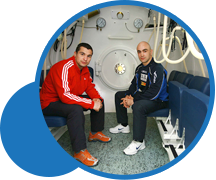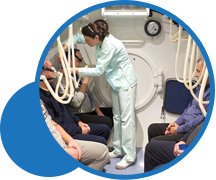Hyperbaric oxygenation HBOT
HBOT in medical rehabilitations and sports medicine

THE ROLE OF HBOT IN REHABILITATION
HBOT is used as a valuable adjunct in early and later rehabilitation after many trauma conditions. Hypoxia is one of the most important causes or consequences in the majority of all disease and in all traumas. Apparent in early/basic mechanisms of injury due to damage to circulatory network and neural tissue, it is additionally complicated by edema and immobilization.
Compromised healing and edema per se limit mobility of affected joints and limbs. This
read more here
Hyperbaric oxygen terapy

Why hyperbaric oxygenation (HBOT)?
There is no remedy that could increase oxygen content in blood. The only possible method that has been known so far is increasing quantity of oxygen dissolved in plasma at an increased pressure - hyperbaric oxygenation (HBOT). This scientifically established method of treatment is provided in hyperbaric chambers while the patients breathe pure 100% medical oxygen at a pressure higher than normal pressure (sea level, 1.0 bar), usually at pressures from 2.0.
read more here
Historical development of HBOT
History of development of hyperbaric oxygenation in the world
1772. Carl Wilhelm Scheele, Swedish chemist, discovered oxygen, naming it "fire air".
1774. Joseph Priestly, British chemist, repeating the experiments done previously by Scheele, also "discovers" oxygen, but his name has traditionally remained connected with the historical fact of oxygen discovery, although erroneously.
1789. Lavoisier and Seguin describe oxygen toxicity effects.
1796. Beddoes and Watt published
read more here
